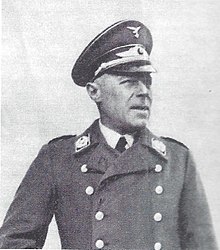Alfred Haubold
Alfred Haubold (born October 28, 1887 in Oelsnitz / Erzgeb. , † February 27, 1969 in Cologne ) was a German general of the flak cartillery in World War II .
Life
Haubold joined the 1st Field Artillery Regiment No. 12 of the Saxon Army as an ensign on March 1, 1908 and was used there as a battery officer after his promotion to lieutenant on September 23, 1909 . He was then from October 1, 1912 to June 30, 1913 a company officer in the 1st Foot Artillery Regiment No. 12 and then adjutant of the III. Department.
In this position Haubold came after the outbreak of the First World War in the context of the XIX. Army Corps with his regiment initially on the Western Front and was promoted to first lieutenant on October 16, 1914 . In November the regiment was withdrawn from there and transferred to the eastern front. Here Haubold was able to distinguish himself several times during the seven-day battles east of Sanniki and in the subsequent battles on the Bzura . From December 26, 1914, Haubold acted as a company commander and on January 11, 1915 he was awarded the Knight's Cross of the Military Order of St. Henry . On November 16, 1916, Haubold was promoted to captain . As such, he was assigned to the General Staff of the XXVII from May 25, 1917 . Reserve Corps and then the 24th Reserve Division until June 25, 1918 . This was followed by his appointment as commander of the foot artillery battalion No. 58. Haubold remained in this position after the end of the war . For his achievements during the war, in addition to both classes of the Iron Cross, he had also received the Knight's Cross First Class of the Albrecht Order with Swords and the Crown.
After the demobilization , Haubold joined the staff of his main regiment on February 1, 1919. Hence the as formed Freikorps frontier Hunter Division 4 active in the Haubold as a battery commander was active. On October 1, 1919, Haubold was accepted into the Reichswehr and initially assigned to the Reichswehr Artillery Regiment 19. From January 1, 1921 to October 31, 1925, he was the battery chief in the 4th Artillery Regiment . There he rose to the regimental staff on November 1, 1925. From February 1, 1928 to the end of January 1930, Haubold, who had been a major since December 1, 1929 , was employed at the commandant's office of the Jüterbog artillery firing range. In February 1930, Haubold transferred to the headquarters of the Berlin Command, where he remained until the end of March 1933. He then became a consultant in the Reichswehr Ministry and was promoted to lieutenant colonel in this capacity on January 1, 1934 . On October 1, 1934, Haubold was appointed commander of the Döberitz flak school and a year later, on April 1, 1935, while joining the Air Force , he was appointed commander of the flak school on Wustrow . There he was promoted to colonel on October 1, 1935 .
From February 1, 1938 to mid-November 1939, Haubold worked as inspector of the anti-aircraft cartillery in the Reich Ministry of Aviation and in the meantime became major general on April 1, 1938 . Subsequently, after the beginning of the Second World War, he was entrusted with the management of the anti-aircraft forces deployed in Luftgau VI and XI. After being promoted to lieutenant general , Haubold served as commanding general and commander in Luftgau Holland during the campaign in the west from May to the end of June 1940 . He then returned to Germany, where he was appointed Commanding General and Commander in Luftgau III ( Berlin ) on July 1, 1940 . In this capacity he was promoted to General of the Flak Cartillery on October 1, 1941. At the end of July 1943, he was replaced and Haubold was subsequently transferred to the Führer Reserve . On September 30, 1943, he retired from active military service and received the German silver cross on October 11, 1943 .
Arrested by the Soviet occupying forces on June 16, 1945 after the end of the war , Haubold was a Soviet prisoner of war until September 26, 1949 .
literature
- Dermot Bradley (ed.), Karl Friedrich Hildebrand: The Generals of the German Air Force 1935-1945. Volume 2: Habermehl – Nuber. Biblio Verlag, Osnabrück 1991, ISBN 3-7648-1701-1 , pp. 41-42.
Individual evidence
- ↑ The Royal Saxon Military St. Heinrichs Order 1736-1918. An honor sheet of the Saxon Army. Wilhelm and Bertha von Baensch Foundation, Dresden 1937, p. 296.
- ↑ Reichswehr Ministry (Ed.): Ranking list of the German Reichsheeres. ES Mittler & Sohn , Berlin 1930, p. 128.
- ↑ Klaus D. Patzwall , Veit Scherzer : The German Cross 1941-1945. History and owner. Volume II, Verlag Klaus D. Patzwall, Norderstedt 2001, ISBN 3-931533-45-X , p. 543.
| personal data | |
|---|---|
| SURNAME | Haubold, Alfred |
| BRIEF DESCRIPTION | German general of the anti-aircraft cartillery in World War II |
| DATE OF BIRTH | October 28, 1887 |
| PLACE OF BIRTH | Oelsnitz / Erzgeb. |
| DATE OF DEATH | February 27, 1969 |
| Place of death | Cologne |
